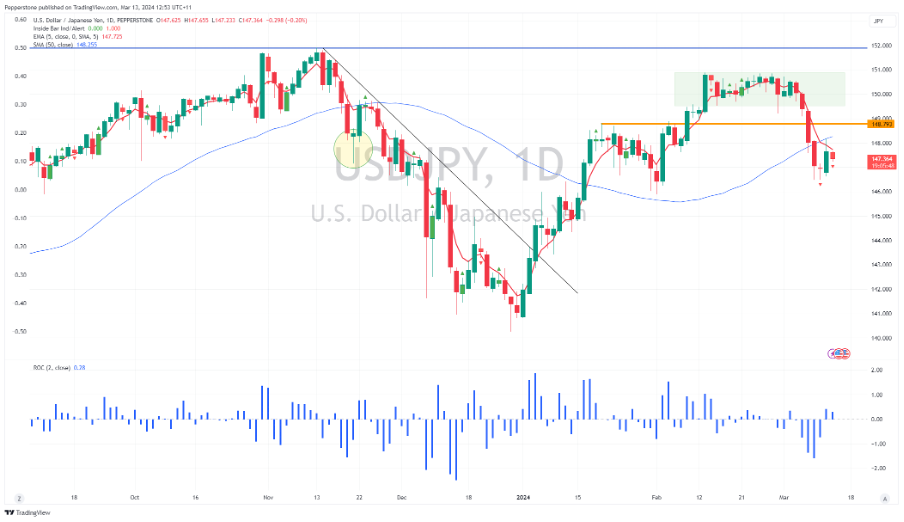Analysis
BoJ meeting Playbook – a landmine for the JPY but no game-changer

Recent press reports have raised expectations that the Bank of Japan (BoJ) is preparing the ground to move away from its non-conventional monetary policy setting. This would essentially see the BoJ raise its policy interest rate from -0.1% (Negative Interest Rate Policy or NIRP) to 0.0%.
There could also be a formal removal of the 1% soft limit on Yield Curve Control (YCC), as well as changes around the purchases of risk assets, such as ETF’s.
Changes to its asset purchases could have implications for the trajectory of the BoJ’s ever-expanding balance sheet.
The question for traders is whether the BoJ’s actions/inactions pose a significant risk event for the JPY and JPN225 index, a clear consideration for traders to have to manage.
There are several ways to assess the risk of exposures
Firstly, it is worth noting that market expectations could move sharply depending on the results of Japan’s Spring wage negotiations (due 15 March). Unions are pushing an increase of close to 6% which would still constitute the largest lift in wages since the 1990’s, although we’re likely to see it settle closer to 5%.
While this data only covers wage increases in larger Japanese corporates, it matters for the BoJ’s thought process, so it will matter to market expectations.
What is priced in Japan rates markets?
We see that there are 7bp of hikes priced in Japanese swaps for the March BoJ meeting, detailing a 70% implied chance of a 10bp hike. This central pricing has been given tailwinds by recent coverage in the Jiji publication that the BoJ could lift rates if the wages are increased “significantly” above 3.8% y/y.
So, all things being equal while the market has gone someway to pricing a 10bp hike, we could still see a quick-fire JPY rally if it plays out. Although the extent of the move depends on the BoJ’s statement, where it seems incredibly likely that if they hike then the statement will show no urgency to hike rates again in the near-term.
Importantly, there is clearly a big difference between a token move away from NIRP and the start of a hiking cycle, which we’ve all seen in other G10 FX countries.

Conversely, if the BoJ leaves policy unchanged we would likely see a spike lower in the JPY, but again the fall could be cushioned by the statement suggesting it is coming in April. It feels clear to me that if the BoJ doesn’t alter policy at the March meeting, then there is a very high chance of a hike in the April meeting – so barring a quick change in positioning, does it really matter whether its March vs April?
By way of economist expectations, a recent survey by Bloomberg detailed that 54% of respondents (of 50) thought the April meeting was the more likely time for a hike, although this number had declined from the poll conducted in January. 38% of economists see the March meeting as a likely date, but this could increase depending on the outcome of the Spring wage negotiations.
Expected movement – implied volatility
If we look at the options market, we see that USDJPY 1-week implied volatility sits at 11.5%, which is the 43rd percentile of the 12-month range, although I expect this to rise as we head into a big week of event risk. We can quantify the expected move through options volatility strategies (such as straddles or strangles) and see the implied move (higher or lower with a 68% level of confidence) over the week in USDJPY is 210-pips – this suggests a playing range over this timeframe of 149.71 to 145.49.
Market interest is heating up.
Weekly mentions of “BoJ” in global media

Scanning news publications for mentions of ‘BoJ’ we are seeing good interest to report on the meeting, although the level of coverage is certainly not at extreme levels, such as what we saw in December 2022. Typically, the more interest in the meeting the greater the potential for outsized moves that JPY traders need to manage.
On the client side, we are seeing good two-way interest in trading USDJPY, and the JPY crosses and volumes have certainly picked up, suggesting elevated interest in the BoJ meeting.
Another key factor that could impact the extent of the move over news is positioning.

Many focus on the weekly Commitment of Traders (CoT) report, where we see that JPY positioning held by non-commercial accounts at a multi-year net short. We also see the faster-moving leveraged community net short by some 78k JPY futures contracts – the largest net short position since 2018.
That said, I am always sceptical of the weekly CoT FX futures report, given so often this figure is at odds with the skew seen by investment bank flow desks.
We can look at the price action and technicals and see the JPY has been finding buying activity since 23 Feb, with some signs that traders are massaging JPY short positioning into the meeting, notably vs the NZD and USD.
In summary
The BoJ meeting is a clear event risk that traders will need to review exposures over – where the key focus is on whether the bank look to hike rates at this meeting or signal one is coming in April, although there are other factors to consider such as the implied levels of future bond purchases. The prospect of a short sharp move in the JPY is real, but unless we see a significant move in the Japanese bond market and more hikes being priced through 2024, then it shouldn’t be a game changer for the JPY and USDJPY will soon revert to aligning with the US-JP bond yield differentials.
Related articles
The material provided here has not been prepared in accordance with legal requirements designed to promote the independence of investment research and as such is considered to be a marketing communication. Whilst it is not subject to any prohibition on dealing ahead of the dissemination of investment research we will not seek to take any advantage before providing it to our clients.
Pepperstone doesn’t represent that the material provided here is accurate, current or complete, and therefore shouldn’t be relied upon as such. The information, whether from a third party or not, isn’t to be considered as a recommendation; or an offer to buy or sell; or the solicitation of an offer to buy or sell any security, financial product or instrument; or to participate in any particular trading strategy. It does not take into account readers’ financial situation or investment objectives. We advise any readers of this content to seek their own advice. Without the approval of Pepperstone, reproduction or redistribution of this information isn’t permitted.

